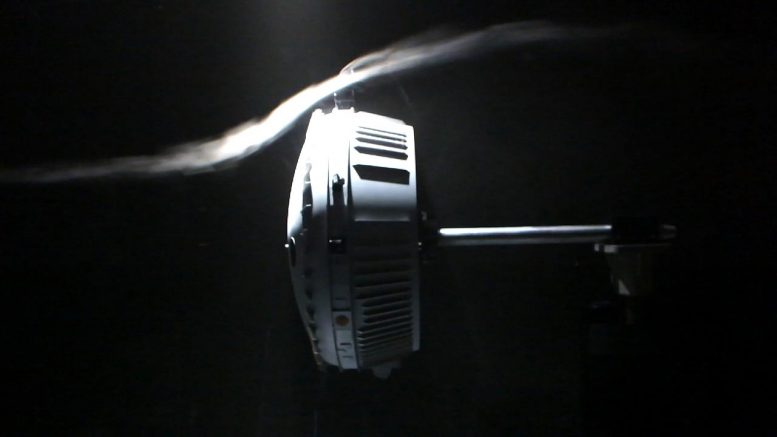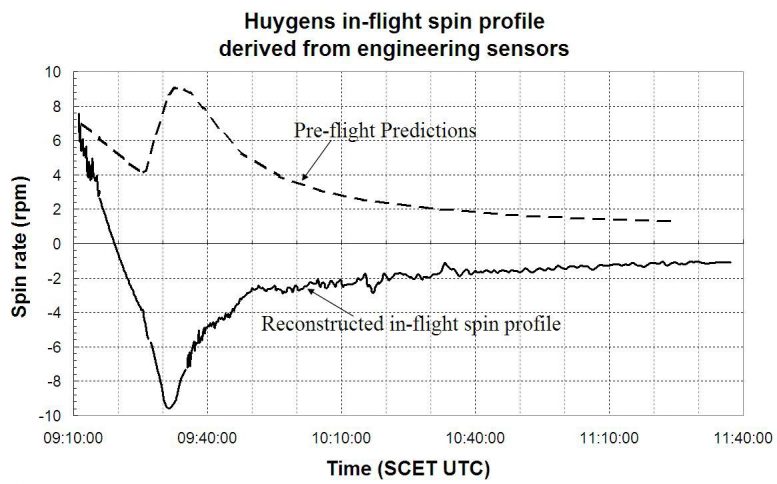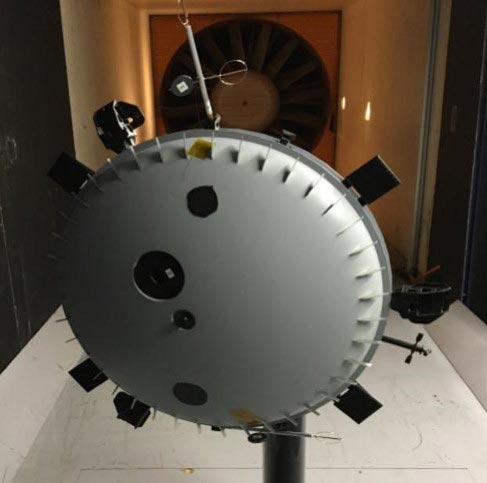After 15 Years, Scientists Finally Solve Huygens Landing Spin Mystery

As part of the international Cassini mission, ESA’s Huygens probe made history on January 14, 2005, when it became the first probe to successfully land on another world in the outer Solar System. However, during its descent, the probe began spinning the ‘wrong’ way – and new results confirm why.
The image, produced in the wind tunnel at the PRISME Laboratory at the University of Orléans, France, shows how air flows across a 1:3 scale replica of Huygens – as visualized using white smoke. It was taken as part of subsonic testing performed from 2017 to 2019 to determine how ESA’s Huygens probe spun during its descent to Titan.
Huygens was released from Cassini spinning anti-clockwise but, approximately 10 minutes after entering Titan’s atmosphere, the probe’s spin unexpectedly reversed to become clockwise. It kept spinning this way for the rest of the descent; luckily, the magnitude of this reversed spin was similar to that expected by the researchers, meaning that the unexpected flip affected the timing of the planned observations, but did not dramatically affect their quality.
The recent tests now confirm the cause of this flip in spin direction. While the probe was equipped with vanes to regulate its spin, other appendages on the spacecraft produced a torque in the opposite direction; this was only exacerbated by the way in which these vanes redirected the gas flow around the body of the probe, so that an overall ‘negative’, or clockwise, spin effect was created. There are also indications that the booms of the Huygens Atmospheric Structure Instrument (HASI) might have not been fully or symmetrically deployed during descent; this effect is under further investigation.
Credit: CNRS/LPC2E/PRISME
The image, produced in the wind tunnel at the PRISME Laboratory at the University of Orléans, France, shows how air flows across a 1:3 scale replica of Huygens – as visualized using white smoke. It was taken as part of subsonic testing performed from 2017 to 2019 to determine how ESA’s Huygens probe spun during its descent to Titan.
Huygens was released from Cassini spinning anti-clockwise but, approximately 10 minutes after entering Titan’s atmosphere, the probe’s spin unexpectedly reversed to become clockwise. It kept spinning this way for the rest of the descent; luckily, the magnitude of this reversed spin was similar to that expected by the researchers, meaning that the unexpected flip affected the timing of the planned observations, but did not dramatically affect their quality.
The recent tests now confirm the cause of this flip in spin direction. While the probe was equipped with vanes to regulate its spin, other appendages on the spacecraft produced a torque in the opposite direction; this was only exacerbated by the way in which these vanes redirected the gas flow around the body of the probe, so that an overall ‘negative’, or clockwise, spin effect was created. There are also indications that the booms of the Huygens Atmospheric Structure Instrument (HASI) might have not been fully or symmetrically deployed during descent; this effect is under further investigation.
Credit: CNRS/LPC2E/PRISME
Fifteen years ago, ESA’s Huygens probe made history when it descended to the surface of Saturn’s moon Titan and became the first probe to successfully land on another world in the outer Solar System. However, during its descent, the probe began spinning the wrong way – and recent tests now reveal why.
Launched in 1997, the NASA/ESA/ASI Cassini-Huygens mission remains iconic and has contributed an enormous amount to our understanding of Saturn and its moon Titan since its arrival at the ringed planet in late 2004.
The mission comprised an orbiter, Cassini, which went on to orbit Saturn for over 13 years after becoming the first spacecraft to do so, and a small atmospheric probe, ESA’s Huygens lander, which headed down to explore the physical properties and atmosphere of Titan on 14 January 2005.
Huygens’ risky descent lasted for 2 hours and 27 minutes, and the data the small probe gathered went on to facilitate a wealth of discoveries about this fascinating moon.
A rendering of Huygens descent and touchdown created using real data recorded by the probe’s instruments as it descended to the surface of Titan, Saturn’s largest moon, on January 14, 2005.
The animation takes into account Titan’s atmospheric conditions, including the Sun and wind direction, the behavior of the parachute (with some artistic interpretation only on the movement of the ropes after touchdown), and the dynamics of the landing itself. Even the stones immediately facing Huygens were rendered to match the photograph of the landing site returned from the probe, which is revealed at the end of the animation.
The lander returned the first in situ measurements of Titan’s atmosphere, determining its pressure, density and temperature from an altitude of 1400km down to the surface. The probe’s Doppler Wind Experiment (DWE) spotted strong east-west winds in the moon’s atmosphere, some of which rotated faster than the moon itself. It shed light on why Titan’s atmosphere contains methane, nitrogen, and tiny aerosols, and in what quantities, and detected signs of geological processes and features in the moon’s interior such as cryovolcanism and, potentially, a large subsurface ocean.

This graph shows the ‘spin profile’ of ESA’s Huygens probe as it descended to the surface of the Saturnian moon Titan on January 14, 2005: the dotted line shows the predicted profile, while the solid line shows the actual profile as tracked by the probe’s onboard engineering sensors. The horizontal axis indicates UTC time and the vertical axis the spin rate (in revolutions per minute).
As part of the international Cassini mission, Huygens made history when it became the first probe to successfully land on another world in the outer Solar System. However, during its descent, the probe began spinning the ‘wrong’ way – as this graph illustrates. Huygens was released from the Cassini orbiter spinning anti-clockwise at a rate of 7.5 rotations per minute. This direction of spin was intended to continue throughout the descent, with the spin rate controlled and influenced by the deployment of landing parachutes.
These results were obtained via subsonic wind tunnel testing at the PRISME Laboratory at the University of Orléans, France.
Credit: Reproduced from Lebreton et al. (2005)
As part of the international Cassini mission, Huygens made history when it became the first probe to successfully land on another world in the outer Solar System. However, during its descent, the probe began spinning the ‘wrong’ way – as this graph illustrates. Huygens was released from the Cassini orbiter spinning anti-clockwise at a rate of 7.5 rotations per minute. This direction of spin was intended to continue throughout the descent, with the spin rate controlled and influenced by the deployment of landing parachutes.
These results were obtained via subsonic wind tunnel testing at the PRISME Laboratory at the University of Orléans, France.
Credit: Reproduced from Lebreton et al. (2005)
By cutting through and exploring the thick haze that enshrouds the moon, the probe also helped scientists to visualize the surface of Titan, returning evidence of past watery activity, such as dried up riverbeds and drainage networks and long-empty lake basins, and observations of the vast dunes of sand and ice.
However, one thing remained a mystery: why Huygens spun in the ‘wrong’ direction during its descent. The probe was released from Cassini spinning anti-clockwise at a rate of 7.5 rotations per minute. Due to the design of the probe, its spin rate helped to keep Huygens stable firstly as it spent three weeks coasting down to Titan, and then as it eventually entered the moon’s atmosphere.
This movie was produced in the wind tunnel at the PRISME Laboratory at the University of Orléans, France, where subsonic testing was performed from 2017 to 2019 to determine how ESA’s Huygens probe spun during its descent to Titan.
Although Huygens initially behaved as anticipated, during descent the probe’s spin rate decreased far more rapidly than expected, before reversing after approximately 10 minutes to adopt a clockwise direction.
It kept spinning this way for the remaining 2 hours and 15 hours of descent; luckily, the magnitude of this reversed spin was similar to that expected by the researchers, meaning that the unexpected flip affected the timing of the planned observations, but did not dramatically affect their quality.

This image shows a replica of ESA’s Huygens probe, as used in recent wind tunnel testing to characterize how the spacecraft spun as it descended to the surface of Titan – an event that made history on 14 January 2005. This mock-up is at a scale of 1/3 – the real Huygens probe, and appendages, was 3 times bigger.
Various booms and appendages can be seen around the probe, including four flat Radar Altimeter antennas, two deployable booms for the Huygens Atmospheric Structure Instrument (HASI), different telemetry and sensor heads, pressure and temperature sensors, and the mechanism by which the heat shield and coverings would detach after atmospheric entry. This side of the spacecraft would be the side to touch down on the surface of Titan; the probe’s descent parachute is stored on the side not in view.
In this image, the mock-up is deployed in the test section of the wind tunnel at the PRISME Laboratory at the University of Orléans, France, where subsonic testing was performed from 2017 to 2019 to determine the spin profile of Huygens during its descent.
Credit: CNRS/LPC2E/PRISME; ESA
Various booms and appendages can be seen around the probe, including four flat Radar Altimeter antennas, two deployable booms for the Huygens Atmospheric Structure Instrument (HASI), different telemetry and sensor heads, pressure and temperature sensors, and the mechanism by which the heat shield and coverings would detach after atmospheric entry. This side of the spacecraft would be the side to touch down on the surface of Titan; the probe’s descent parachute is stored on the side not in view.
In this image, the mock-up is deployed in the test section of the wind tunnel at the PRISME Laboratory at the University of Orléans, France, where subsonic testing was performed from 2017 to 2019 to determine the spin profile of Huygens during its descent.
Credit: CNRS/LPC2E/PRISME; ESA
Previous studies have investigated this behavior (for example a study conducted by Vorticity in 2014–2015) and recent subsonic wind tunnel testing at the PRISME Laboratory at the University of Orléans, France, now confirms the main cause. The study was carried out from 2017 to 2019 under an ESA contract with LPC2E/CNRS-University of Orléans.
Huygens was equipped with 36 angled vanes that were used to control the spin of the descent module. However, two of the probe’s main appendages, the Separation Subsystem (SEPS) and the Radar Altimeter (RA) antennae, actually produced an unexpected torque opposite to that produced by the vanes. This effect was amplified as the vanes altered the gas flow around the descent module in a way that enhanced the amplitude of the ‘negative torque’ – the effect that made Huygens flip its direction of spin – until it exceeded the influence of the vanes.
The resolution of this engineering mystery will help inform the design of entry probes in the future, furthering our exploration of the Solar System.
No comments:
Post a Comment